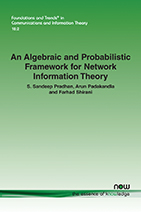An Algebraic and Probabilistic Framework for Network Information Theory
By S. Sandeep Pradhan, University of Michigan, USA, pradhanv@umich.edu | Arun Padakandla, University of Tennessee, USA, arunpr@utk.edu | Farhad Shirani, North Dakota State University, USA, f.shiranichaharsoogh@ndsu.edu
Abstract
In this monograph, we develop a mathematical framework based on asymptotically good random structured codes, i.e., codes possessing algebraic properties, for network information theory. We use these codes to propose new strategies for communication in multi-terminal settings. The proposed coding strategies are applicable to arbitrary instances of the multi-terminal communication problems under consideration. In particular, we consider four fundamental problems which can be considered as building blocks of networks: distributed source coding, interference channels, multiple-access channels with distributed states and multiple description source coding. We then develop a systematic framework for characterizing the performance limits of these strategies for these problems from an information-theoretic viewpoint. Lastly, we identify several examples of the multiterminal communication problems studied herein, for which structured codes attain optimality, and provide strictly better performance as compared to classical techniques based on unstructured codes. In summary, we develop an algebraic and probabilistic framework to demonstrate the fundamental role played by structured codes in multiterminal communication problems. This monograph deals exclusively with discrete source and channel coding problems.
An Algebraic and Probabilistic Framework for Network Information Theory
In the recent past, many components of modern infrastructure such as transportation systems, power systems, climate and environment monitoring systems, education systems and even government are being increasingly interconnected through information networks. Central to the functioning of current-day information networks are strategies that facilitate distributed network information processing objectives. In this monograph, the authors address the overarching challenge of designing efficient information processing strategies from a fundamental network information theory viewpoint.
The authors address several network communication problems which can be considered as building blocks of networks. They consider these problems from both the data transmission and the data storage perspectives. They devise structured coding schemes for the finite alphabet cases of these problems and for each problem provide at least one example where they prove that the structured coding scheme is optimal, whereas the unstructured coding scheme is strictly suboptimal. Toward studying the information-theoretic performance limits in each of these communication scenarios, they consider two key concepts: common information and code structure. They uncover a new fundamental connection between them, and develop the key elements of a unified coding framework.
This monograph is aimed at students, researchers and practitioners in information theory and communications. It provides an in-depth discussion of the theory and techniques resulting in a framework that the reader can apply to further their own work.
